Having Trouble in Thick Rough? PING May Have the Solution
How often do you think about the leading edge of your irons? Sure, golfers often think about “bounce” but what about the actual leading edge? Fortunately, the engineers at Karsten (aka PING) are thinking about these things for us as witnessed by an interesting patent application that published today.
The application published as US Pub. No. 20120034997 titled “Golf Club Heads with Edge Configuration and Methods to Manufacture Golf Club Heads,” which explains:
BACKGROUND
[0003] Golf club heads currently have a leading edge defining a smooth radius that transitions from the face to the sole of a golf club head. This type of leading edge is designed to cut through soil and possibly create a divot. Although a golf club head with a leading edge defining a smooth radius has proven satisfactory in most shot situations, shots made from deep and/or wet grass present certain challenges. In particular, an individual who strikes the ball in deep grass can have the golf club head twist as it contacts and breaks the tall blades of grass. Further, debris such as dirt, grass and/or water can cause the golf ball to “slide up”, rather than “roll up”, the face of the golf club head after impact since such debris can impede the progress of the golf ball as it travels along the face of the golf club head after impact. In addition, golf club heads with a smooth radius along the leading edge also can inhibit the golf club head from shearing blades of grass when the golf club is swung through the rough, especially for individuals who may hit low on the face of the golf club head. To address these issues, the leading edge of the golf club head may be sharpened. However, a sharpened leading edge can cut the ball and cause the golf club head to dig into the ground once the golf club head comes into contact with the soil.
.
.
.
DESCRIPTION OF EXAMPLES OF EMBODIMENTS[0022] Golf club heads typically have a leading edge with a smooth radius that transitions from the face to the sole of a golf club head. When swinging out of rough or other tall grass areas, the smooth radius leading edge may not provide optimal performance in such playing conditions. For instance, the leading edge with a smooth radius tends to break, rather than cleanly shear the tall grass, thereby causing the golf club head to become twisted as the golf club is swung through the grass. In addition, golf club heads with a leading edge having a smooth radius can also cause the golf ball to “slide up” the face of the golf club head after impact, rather than “roll up” the face of the golf club head. By sliding up the face instead of rolling up, the golf ball may engage from the face and rotate in a manner that may result in non-optimal ball flight trajectory.
[0023] As such, the golf club head with an edge configuration defining a channel and method of manufacturing such an edge configuration as described herein may provide optimal performance in certain playing conditions by configuring the leading edge of the club head to address these issues.
.
.
.
[0028] The channel 130 is also configured to receive portions of a hitting surface (not shown) such as the ground of a fairway or rough of a golf course, when the leading edge 128 impacts the hitting surface. The configuration of the channel 130 to receive portion of debris also allows the golf ball to “roll up” the face 112, rather than “slide up” the face 112 after impact since the channel 130 clears the face 112 of any debris, such as dirt, grass, and/or water. As such, there is a greater coefficient of friction generated between the face 112 and the golf ball that causes the golf ball to “roll up” the face 112 unimpeded in comparison to when debris is present between the face 112 and the golf ball which impedes the golf ball and generates a smaller coefficient of friction between the face 112 and the golf ball, thereby causing the golf ball to “slide up” the face 112 when the leading edge 128 has a smooth radius. Accordingly, the channel 130 may clear out water, sand, grass, and/or other debris between a golf ball and the golf club head 100 to generate a much greater coefficient of friction between the golf ball and the face 112 of the golf club head 100.
.
.
.
[0033] Although the above example may describe and FIGS. 6 and 7 may depict an edge configuration with a C-shaped channel, the apparatus, articles of manufacture, and methods described herein may include edge configurations with channels having other suitable cross-section profiles, a V-shaped cross-section profile (FIG. 14), a W-shaped cross-section profile (FIG. 15) or a square-shaped cross-section profile (FIG. 16) as shall be described in greater detail below.
Check out these grooves!
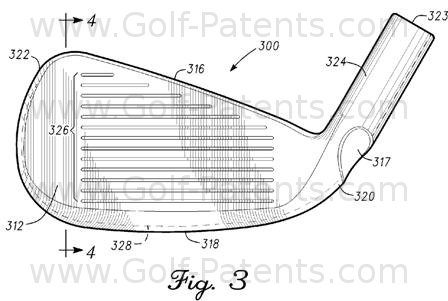
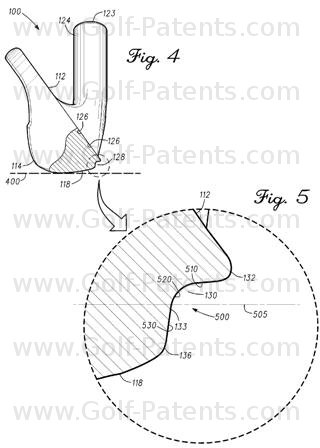
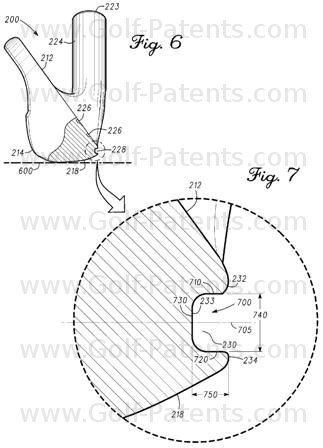
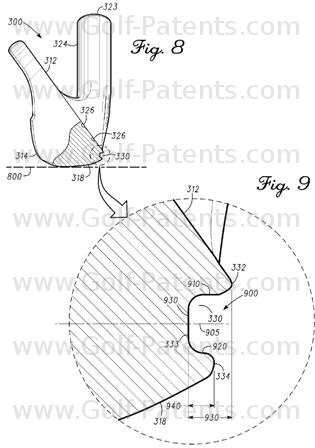
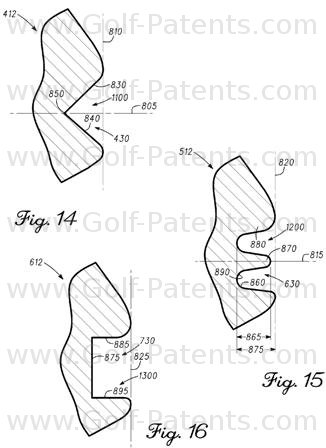
How would you like to cleanly shear tall grass when going after a ball buried in the rough? I don’t know if it would actually help my game but it is an interesting concept. Nice work.
Dave Dawsey – Monitoring Intellectual Property in the Golf Industry
